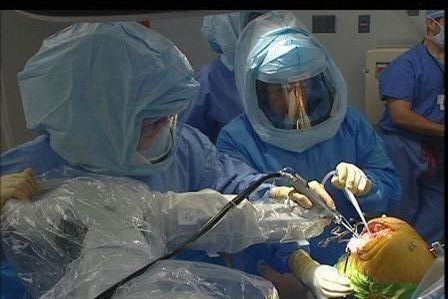 | ||
MAKOplasty is a surgical procedure for partial knee or total hip arthroplasty using a RIO Robotic Arm Interactive Orthopedic System developed by MAKO Surgical Corp. RIO is cleared by the FDA for use in surgical knee and hip procedures, in which the use of stereotactic surgery may be appropriate, and where reference to rigid anatomical bony structures can be identified relative to a CT-based model of anatomy.
Contents
Procedure
MAKOplasty is used to enable surgeons to plan partial knee or total hip replacement procedures by using three-dimensional computer imaging based on a CT scan. This allows them to determine optimal implant size, position, and alignment for each individual patient, and to map out accurately the areas of bone they want to remove. During surgery, the robotic arm system provides visual, auditory, and tactile control to help assure that surgeons cut away only the bone planned to be resected prior to surgery. The procedure is said to take the guesswork out of surgery, resulting in accurate and reproducible results.
Partial knee replacement
For partial-knee replacements, MAKOplasty allows surgeons to remove only the diseased portions of the joint, preserving healthy tissue and ligaments, resulting in a more natural feeling knee. The procedure can be performed on the medial compartment, the lateral compartment, the patello-femoral compartment or on a combination of the medial and the patello-femoral compartments of the knee. Patients with bicompartmental MAKOplasty have improved function over those with total knee replacement surgery, and demonstrate better post-operative range of motion and quadriceps strength compared to total knee arthroplasty.
Interim results from a survivorship study indicate that implants placed with the robotic arm technology have a 0.4% failure rate two years after surgery, compared to 4% of implants placed manually. According to a randomized controlled trial, MAKOplasty patients experience less pain during the first week after surgery than do patients who underwent manual surgery after two months. The same study also concluded that MAKOplasty unicompartmental knee arthroplasty is more accurate than manual unicompartmental knee arthroplasty. A different study reported that MAKOplasty is two-to-three times more accurate than manual techniques for partial knee implant placement.
Total hip replacement
For total hip replacement, MAKOplasty increases accuracy of implant placement into the socket, which reduces potential for impingement, implant wear and dislocation. A study reported that MAKOplasty is four-to-six times more accurate than manual techniques for implant placement. Results from a multicenter trial indicate that 84% of implants placed with MAKOplasty robotic arm technology are in an acceptable range, compared to only 47% of implants placed manually.
Peer review
MAKOplasty data has been published in numerous peer reviewed journals, including Journal of Bone and Joint Surgery, the Journal of Arthroplasty, and the Orthopedics Journal.
